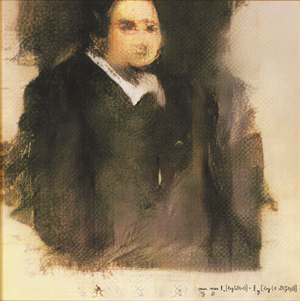運算創意

運算創意(粵拼:wan6 syun3 cong3 ji3;英文:computational creativity,CC)係人工智能(AI)嘅一個子領域,專門研究點樣教電腦展現出好似人一樣噉嘅創意-運算創意上嘅技術通常會模擬創意所涉及嘅認知過程,嘗試教電腦做同樣嘅資訊處理,最後要部機自己產生出展示到創意嘅圖像-模擬畫畫、樂曲-模擬作曲、或者虛構故仔-模擬寫作... 等嘅產物[1][2]。
舉個例說明,《Edmond de Belamy》係一幅 2018 年嘅畫作。幅畫係由一個生成對抗網絡(GAN)產生出嚟嘅:生成對抗網絡係種人工神經網絡技術,用兩個網絡,一個網絡(生成網絡)負責產生一幅圖像 ,而另一個網絡(分辨網絡)會負責分辨幅圖係咪由生成網絡整(唔係由人類整)嘅,分辨網絡睇得出就當個生成網絡輸-迫個生成網絡係噉學習到要產生出同人類作品無異嘅作品[3]。《Edmond de Belamy》俾好多人認為係史上第一幅可以算係由 AI 創作嘅畫,打後仲成功以 432,500 文美金嘅高價賣出[4]。
喺廿世紀尾,運算創意俾唔少人認為係 AI 嘅最後彊界(AI's final frontier)-傳統上,創意俾人認為係人類獨有、機械展現唔到嘅特性,而運算創意响廿一世紀初取得咗一定嘅成功,引起唔少人對 AI 嘅本質同相關嘅哲學問題作出反思[1][5]。
基本定義
[編輯]
創意
[編輯]運算創意嘅目的係想教 AI 展示創意(creativity):要研究運算創意,首先要定義「創意」呢隻詞;喺廿一世紀初嘅認知心理學上,創意俾人當係一種認知功能噉研究,而至於呢隻詞要點定義,心理學家一般認為,新同有用係創意嘅兩大最重要特徵[6],想像:
- 一嚿有用但唔新嘅嘢,定義上唔可以算係創意;
- 一嚿新但冇用嘅嘢,都難以算得上係創意-想像家陣畫畫,一位創作人(或者創作 AI)查實可以隨機噉產生一幅圖出嚟,即係 foreach 畫布上嘅點,隨機揀隻色水填落去;喺絕大多數情況下,噉做係就係會產生一幅前所未有嘅圖像,但唔會產生咩令睇畫人鍾意(用途)嘅產品嘅,所以即係「冇用」;抽象啲噉講,創作嘅過程可以想像成一個人搜尋一個由「可能嘅產品」組成嘅空間,呢個空間當中絕大多數嘅產品都係冇用嘅,而創作人要由個空間嗰度搵一件有用嘅可能產品,再整件嘢出嚟[7];
淨係齋靠諗經已可知,創意必然會涉及多種嘅認知功能:做創作嘅個體要界定個問題、嘗試搵可能嘅答案、仲有係監察住自己件產品係咪達到自己目的... 呀噉,途中會用到思考、解難同決策等嘅多種認知功能[8]。
| 「 | 創意係指諗出又新又有用嘅諗頭嘅過程。
|
」 |
定位
[編輯]AI 係電腦科學同認知科學嘅結合領域,目的係想研究點樣教電腦展示出好似人噉嘅有智能行為:例子有教電腦捉棋(詳情可以睇吓遊戲 AI)以及教電腦學習(詳情可以睇吓機械學習)呀噉。運算創意就係 AI 嘅一環-已知人識得用畫畫、作曲同寫作等嘅方式展現創意,運算創意就係想教電腦做出同樣嘅行為[1]。噉嘅技術有三大類用途[2]:
-可以用一句嘢概括[5]:
| 「 | 」 |
理論基礎
[編輯]運算創意會用到機械學習同人工神經網絡等嘅基本 AI 概念。除此之外,仲有:
整同評估
[編輯]根據心理學上對人類創意嘅研究,創意同實行創意嘅過程包含咗最少兩個步驟[10]:
- 產生諗頭:諗計嘅人要產生一個可能有用嘅新諗頭;
- 評估諗頭:諗計嘅人要評估個新諗頭係咪真係有用;
好似以上噉嘅過程可以用類似生成對抗網絡(generative adversarial network,GAN)嘅方式想像[11]:GAN 係種神經網絡嘅做法;用呢種方法建構神經網絡涉及整兩個網絡,要嗰兩個神經網絡互相競爭,從而產生新而且幾可亂真嘅數據;最基本嗰種 GAN 做法大致如下[12][13]:
- 建立兩個神經網絡;
- 其中一個神經網絡做生成網絡(generative network),負責
output數據,當中「數據」可以係一幅圖像; - 另外嗰個神經網絡就會做分辨網絡(discriminative network),分辨網絡會以生成網絡嘅
output同真數據做自己input,foreach 數據,個分辨網絡要負責嗰件數據係真定假-「假」意思即係話「嗰個output係由個生成網絡老作嘅」; - 對於個生成網絡嚟講,佢最重要嘅目的係要呃到個分辨網絡-即係務求要做到令自己產生嘅數據俾個分辨網絡判定係「真」;
如果呢種方法教 AI 產生圖像(模擬畫畫),個生成網絡開頭嗰陣會齋靠隨機撞嘅方式產生圖像做 output,並且喺分辨網絡成功睇得出幅圖係假嗰時收到訊號。如是者,呢兩個網絡會互相「對抗」,順利嘅話,生成網絡會變到能夠產生幾可亂真嘅數據[14][15]。進階嘅做法仲可以加多幾個唔同嘅分辨網絡,每個負責判斷唔同嘅嘢-例如一個分辨網絡判斷幅圖係咪由 AI 整嘅,另外嗰個就負責判定幅圖「能唔能夠清楚噉分類做某個風格」(如果幅圖明顯屬某個已知嘅風格,就表示幅圖唔夠新穎),個生成網絡要過嗮兩個分辨網絡嘅關先算成功[11]。
概念混成
[編輯]視藝創意
[編輯]音樂創意
[編輯]語言創意
[編輯]哲學問題
[編輯]註釋
[編輯]睇埋
[編輯]文獻
[編輯]- An Overview of Artificial Creativity 互聯網檔案館嘅歸檔,歸檔日期2008-03-25. on Think Artificial.
- Ariza, C. (2009). The interrogator as critic: The turing test and the evaluation of generative music systems. Computer Music Journal, 33(2), 48-70.
- Boden, M. A. (2004). The Creative Mind: Myths and Mechanisms. London: Routledge.
- Bringsjord, S., Bello, P., and Ferrucci, D. (2003). “Creativity, the turing test, and the (better) Lovelace test,” in The Turing Test, ed J. H. Moor (Dordrecht: Springer), 215-239,篇文主張話如果一個系統要算得上係「展現咗創意」,噉充分同必要條件係個系統要能夠誘過一個可重複嘅過程嚟產生某啲 output,而且個 output 冇得齋靠個系統嘅知識基礎、架構同核心功能解釋。
- Carnovalini, F., & Rodà, A. (2020). Computational creativity and music generation systems: An introduction to the state of the art. Frontiers in Artificial Intelligence, 3, 14,呢篇文綜述咗當時有嘅運算創意評估方法,包括圖靈測試、作者自我評價同量化嘅指標(睇埋創意商數)。
- Colton, S., Charnley, J. W., and Pease, A. (2011). "Computational creativity theory: the FACE and IDEA descriptive models," in ICCC (Mexico City), 90-95.
- Colton, S., Pease, A., Corneli, J., Cook, M., and Llano, T. (2014). "Assessing progress in building autonomously creative systems," in ICCC (Ljubljana), 137-145.
- Daza, A., Calvo, H., & Figueroa-Nazuno, J. (2016, June). Automatic text generation by learning from literary structures (PDF). In Proceedings of the Fifth Workshop on Computational Linguistics for Literature (pp. 9-19).
- Elgammal, A., Liu, B., Elhoseiny, M., & Mazzone, M. (2017). Can: Creative adversarial networks, generating" art" by learning about styles and deviating from style norms (PDF). arXiv preprint arXiv:1706.07068,用 GAN 模擬畫畫創作。
- Lamb, C., Brown, D. G., & Clarke, C. L. (2018). Evaluating computational creativity: An interdisciplinary tutorial (PDF). ACM Computing Surveys (CSUR), 51(2), 1-34,呢篇文主張「創意」嘅概念可以分做四 P-Person 創作者、Process 創作者用嚟展現創意嘅一系列行動、Product 指畫作等由創意產生嘅產物、同埋 Press 指周圍負責評價件產物嘅人。
- Mekern, V., Hommel, B., & Sjoerds, Z. (2019). Computational models of creativity: a review of single-process and multi-process recent approaches to demystify creative cognition (PDF). Current Opinion in Behavioral Sciences, 27, 47-54.
- Pearce, M., & Wiggins, G. (2001, April). Towards a framework for the evaluation of machine compositions. In Proceedings of the AISB’01 Symposium on Artificial Intelligence and Creativity in the Arts and Sciences (pp. 22-32).
- Riedl, M. O. (2014). The lovelace 2.0 test of artificial creativity and intelligence. arXiv: 1410.6142.
攷
[編輯]- ↑ 1.0 1.1 1.2 Colton, S., De Mantaras, R. L., & Stock, O. (2009). Computational creativity: Coming of age. AI Magazine, 30(3).
- ↑ 2.0 2.1 Anna Jordanous, Ph.D. (10 April 2014). "What is Computational Creativity?". Retrieved 7 January 2019.
- ↑ A Beginner's Guide to Generative Adversarial Networks (GANs). Pathmind.
- ↑ Cohn, Gabe (2018-10-25). "AI Art at Christie's Sells for $432,500". The New York Times. Retrieved 29 October 2018.
- ↑ 5.0 5.1 Colton, S., & Wiggins, G. A. (2012, August). Computational creativity: The final frontier?. In Ecai (Vol. 12, pp. 21-26).
- ↑ Sternberg, Robert J. (2011). "Creativity". Cognitive Psychology (6 ed.). Cengage Learning. p. 479.
- ↑ Meusburger, Peter (2009). "Milieus of Creativity: The Role of Places, Environments and Spatial Contexts". In Meusburger, P.; Funke, J.; Wunder, E. (eds.). Milieus of Creativity: An Interdisciplinary Approach to Spatiality of Creativity. Springer.
- ↑ Torrance, Paul. "Verbal Tests. Forms A and B-Figural Tests, Forms A and B.". The Torrance Tests of Creative Thinking-Norms-Technical Manual Research Edition. Princeton, New Jersey: Personnel Press. p. 6.
- ↑ Carnovalini, F., & Rodà, A. (2020). Computational creativity and music generation systems: An introduction to the state of the art. Frontiers in Artificial Intelligence, 3, 14.
- ↑ Finke, R., Ward, T., and Smith, S. (1992), Creative cognition: Theory, research and applications, Cambridge: MIT press.
- ↑ 11.0 11.1 Elgammal, A., Liu, B., Elhoseiny, M., & Mazzone, M. (2017). Can: Creative adversarial networks, generating" art" by learning about styles and deviating from style norms (PDF). arXiv preprint arXiv:1706.07068.
- ↑ A Beginner's Guide to Generative Adversarial Networks (GANs). Pathmind.
- ↑ Goodfellow, I. et al. (2014). Generative Adversarial Networks (PDF). Proceedings of the International Conference on Neural Information Processing Systems (NIPS 2014). pp. 2672–2680.
- ↑ Salimans, Tim; Goodfellow, Ian; Zaremba, Wojciech; Cheung, Vicki; Radford, Alec; Chen, Xi (2016). "Improved Techniques for Training GANs".
- ↑ Isola, Phillip; Zhu, Jun-Yan; Zhou, Tinghui; Efros, Alexei (2017). "Image-to-Image Translation with Conditional Adversarial Nets". Computer Vision and Pattern Recognition.





